Drug Discovery Platform – Boron
Our core technology approach is based on the use of boron chemistry for our research and development initiatives. Boron has a distinctive ability to bind with biological targets through a reversible covalent bond and the potential to address biological targets that have been difficult to inhibit using traditional carbon-based molecules.
 Historically, the starting points for small molecule antibiotic drug discovery have been based on natural products or peptides. These molecules typically do not contain boron, which has led to a lack of focus on boron-based compounds and a reduced understanding of the physical and biological properties of boron, thereby limiting the incorporation of this element into drug products. Additionally, boron-based compounds have been historically difficult to synthesize, but recent advancements in the science and practice of boron-based drug research have allowed for its incorporation in drug discovery efforts. In particular, advanced computational techniques have been developed to improve the understanding of boron and its interaction with key biological targets relevant to drug discovery efforts. Additionally, new tools and methods have been developed to facilitate the creation of novel boron-containing compound families. These unique compound families expand the universe of biological targets that can be addressed by small molecule boron-based compounds.
Historically, the starting points for small molecule antibiotic drug discovery have been based on natural products or peptides. These molecules typically do not contain boron, which has led to a lack of focus on boron-based compounds and a reduced understanding of the physical and biological properties of boron, thereby limiting the incorporation of this element into drug products. Additionally, boron-based compounds have been historically difficult to synthesize, but recent advancements in the science and practice of boron-based drug research have allowed for its incorporation in drug discovery efforts. In particular, advanced computational techniques have been developed to improve the understanding of boron and its interaction with key biological targets relevant to drug discovery efforts. Additionally, new tools and methods have been developed to facilitate the creation of novel boron-containing compound families. These unique compound families expand the universe of biological targets that can be addressed by small molecule boron-based compounds.
Boron-based inhibitors typically are highly selective for their biological target, thereby minimizing their potential off-target effects. The ability to modify boron’s reactive center, an activity known as tuning, allows drug developers to modulate key properties of the resulting compounds. Properties such as solubility, permeability, molecular charge at different pH values, and metabolic stability, may be designed such that inhibitors can reach any compartment in the body.
Boron chemistry has proven to be a highly productive technology leading to the discovery of many promising drugs, most notably in infectious diseases. Pioneering work at Anacor Pharmaceuticals led to the generation of a class of boron compounds known as fused boron heterocyclic compounds that demonstrated greatly improved drug-like properties.

